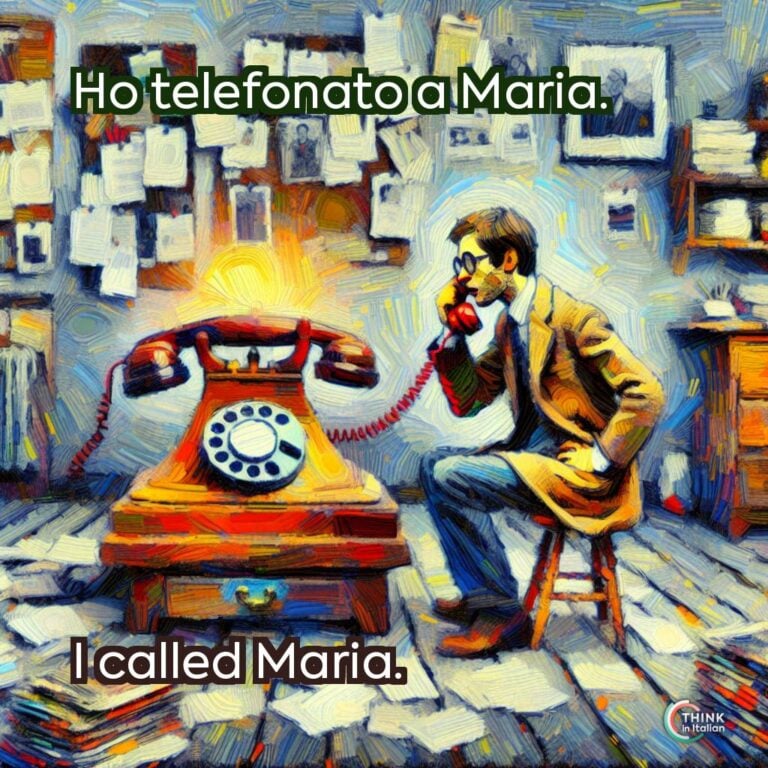Italian Passato Prossimo
The Italian passato prossimo is a compound verb that corresponds to the English present perfect. This verb tense is used to express events and actions that are concluded and completed in the recent past.
It is formed using the present tense of the auxiliary verb avere (to have) or essere (to be) and the past participle of the main verb.
Hai mangiato la pasta che ti ho lasciato?
Have you eaten the pasta that I have left for you?
No, sono appena tornato a casa.
No, I have just come back.
As you might know already, the choice between avere and essere depends on the verb:
- avere is used with transitive verbs, that is, verbs that select a direct object which requires no preposition to be introduced. Examples of transitive verbs are mangiare (to eat), guardare (to look), prendere (to take)…
- essere is used with intransitive verbs that take a indirect object and, therefore, require a preposition to be liked to their object. These intransitive verbs usually indicate motion or a change of state.
How to Conjugate the Italian Passato Prossimo
Passato Prossimo With “Avere”
In order for you to properly conjugate compound verbs like the Italian passato prossimo, you must know the conjugation of the auxiliary verbs in the corresponding verb tense. In this case, you have to know the indicative present.
So, let me guide you through the conjugation of the Italian passato prossimo with the auxiliary avere:
| Subject Pronoun | Conjugation |
|---|---|
| Io | ho |
| Tu | hai |
| Lui/Lei | ha |
| Noi | abbiamo |
| Voi | avete |
| Loro | hanno |
Regular past participles are conjugated as follows:
| Conjugation | Verb | Past Participle |
|---|---|---|
| -are | Comprare | comprato |
| -ere | Credere | creduto |
| -ire | Finire | finito |
For example:
Abbiamo parlato con la nuova fidanzata di Paolo, è simpatica.
We have spoken to Paolo’s new girlfriend, she’s nice.
Marco ha venduto la casa al mare.
Marco sold the beach house.
Hai sentito le notizie di oggi?
Have you heard today’s news?
Passato Prossimo With “Essere”
The same construction is used with the auxiliary verb essere:
| Subject Pronoun | Conjugation |
|---|---|
| Io | sono |
| Tu | sei |
| Lui/Lei | è |
| Noi | siamo |
| Voi | siete |
| Loro | sono |
However, there is an important aspect you must keep in mind when using the auxiliary verb essere: the conjugation of the past participle. In fact, the past participle in Italian must agree in gender and number with the subject when it is used in combination with the auxiliary verb essere.
For example:
Sonia è andata a Roma con suo marito.
Sonia has gone to Rome with her husband.
Siamo rimasti alla festa fino alle 23.
We stayed at the party until 23.
Siete uscite senza ombrello!
You went out without an umbrella!
As you can see, the past participles of the verbs andare, rimanere, and uscire agree respectively with the feminine singular, masculine plural, and feminine plural subjects.
Also, notice that the verb rimanere has an irregular past participle and, therefore, an irregular passato prossimo: Italian has many of those, and it’s best if you learn them by heart.
Passato Prossimo and Adverbs
The Italian passato prossimo is often used with adverbs to specify the time, manner, or extent of an action. Here’s a guide on how to use it with common adverbs:
- Ieri(yesterday)
Ieri ho mangiato una pizza.
Yesterday I ate a pizza.
- Oggi(today)
Oggi ho finito il lavoro.
Today I finished the work.
- Già(already)
Ho già visto quel film.
I have already seen that movie.
- Mai (ever/never)
Non sono mai stata a Roma.
I have never been in Rome.
- Ancora (still/yet)
Non ho ancora fatto i compiti.
I haven’t done the homework yet.
Remember: in Italian the double negation is mandatory!
- Sempre (always)
Ho sempre amato l’Italia.
I have always loved Italy.
- Spesso (often)
Ho visitato spesso i miei nonni.
I have often visited my grandparents.
- Raramente (rarely)
Ho raramente mangiato sushi.
I have rarely eaten sushi.
What is important to keep in mind is the order of these adverbs in the sentence: they typically come after the auxiliary verb and before the past participle. There are some exceptions, like spesso, but their placement is flexible, rather than exceptional.
Passato Prossimo vs Imperfetto
The Italian passato prossimo is very commonly confused with the Italian imperfetto, which is another past tense. Although these two verbs can be used together, they express different types of past actions and it is important that you understand the difference.
Passato prossimo is used for completed actions that have an effect on the present or occurred at a specific time, while imperfetto describes habitual actions or ongoing events in the past without a defined endpoint.
When used together, imperfetto can be used for the background action and passato prossimo for the interrupting action when both tenses appear together, as in the example below:
Mentre studiavo, ho fatto merenda.
While I was studying, I had a snack.
Learn more about the different uses of passato prossimo and imperfetto.
Hai Capito?
Have you understood?
Now that you’ve learned the Italian passato prossimo you are ready to express past finished events and actions. This tense is used when we want to talk about actions, events, and facts that happened in the past, but not long ago.
Make sure you learn the irregular past participles and the proper use of adverbs, and go tell your past stories to your Italian friends!




